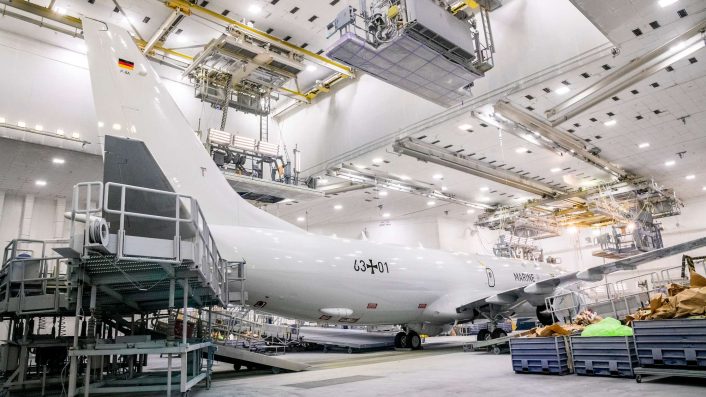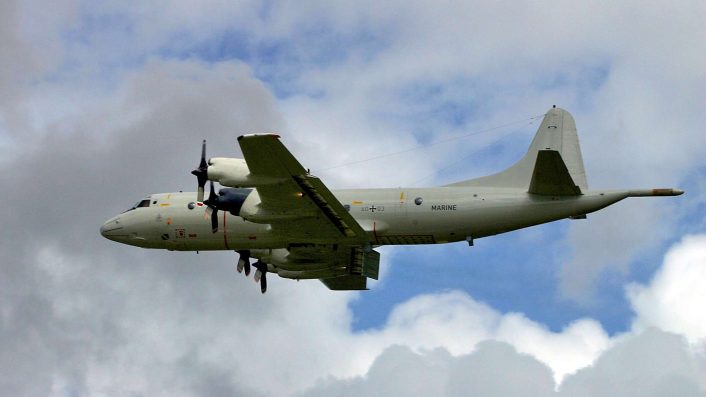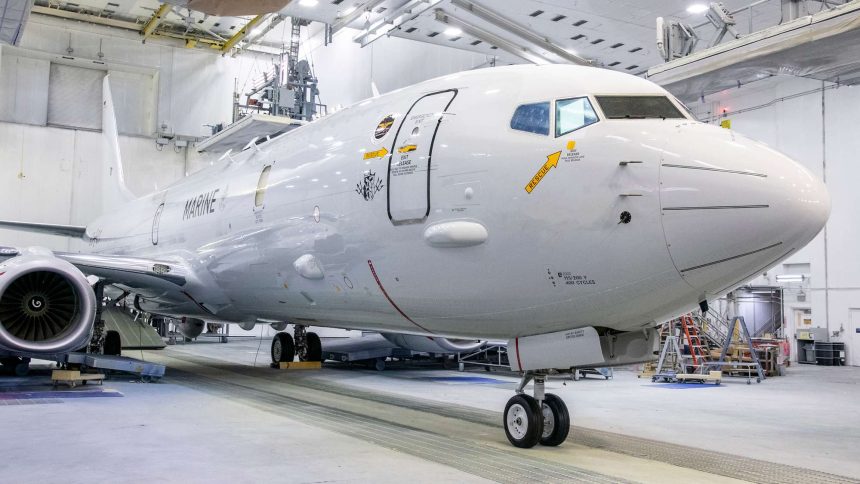The first German P-8A Poseidon has received the complete German Navy livery and is expected to be delivered by August 2025, starting the replacement of the older P-3C Orion Maritime Patrol Aircraft.
The German Navy’s (Deutsche Marine) first Boeing P-8A Poseidon Maritime Patrol Aircraft (MPA) has received full German colors and markings at Boeing’s factory in Seattle, Washington, the Bundeswehr revealed. Bearing the tail number 170528 and registration 63+01, this will be the first of eight aircraft that Berlin contracted in a recent Foreign Military Sales (FMS) program.
The first five aircraft were contracted in June 2021, with three more added in Nov. 2023. This first aircraft is expected to be delivered by August 2025 once it clears the functionalities’ testing.
The Bundeswehr highlighted that the aircraft moved from the contract award to finishing construction and receiving the national livery and insignia within just four years. The P-8A Poseidon will replace the older P-3C Orion, which completed a modernization program in June 2020.
The Bundeswher said in 2021, when it announced the acquisition of the Poseidon, that it was an interim solution. In fact, with the Orions planned to retire in 2025 and the German-French Maritime Airborne Warfare System (MAWS) expected to be fielded in 2035, a ten-year capability gap had to be filled. However, with France now launching a feasibility study on its own for an MPA variant of the A321 and Germany ordering more P-8As, it remains to be seen if it will remain an interim solution.
🇩🇪 Frisch lackiert für die Marineflieger!
Boeing P-8 Poseidonhttps://t.co/CjJv5xyEDD pic.twitter.com/zpU3AihRIM
— Menno Swart (@MennoSwart) February 4, 2025
Germany becomes the eighth P-8 Poseidon user after the U.S., Australia, U.K., India, South Korea, Norway and New Zealand, with Canada becoming the ninth. A total of 130 P-8s are flying today, collectively counting over 300,000 flight hours.
Here we are…#Boeing P8 #Poseidon
The first German P-8A Poseidon has just been painted at the Boieng factory in Seattle. Complete with all the markings and emblems, the new maritime patrol aircraft looks and feels like a German Navy submarine chaser.#Bundeswehr pic.twitter.com/MNfCMiRTza
— Boris Alexander Beissner (@boris_beissner) February 5, 2025
Conversion and maintenance
Boeing said that the aircraft, with the livery now completed, has been moved from the airliner’s paint booth to the Boeing Defense facility where it will receive its mission systems. Once the aircraft is mission ready and passes the testing phase, it will be delivered to the German Navy’s Naval Air Wing 3.
🇩🇪 The 1st German “Poseidon”
Boeing has released photographs and a video showing the first P-8A Poseidon maritime patrol aircraft (reg. 63+01) for the German Navy.#Germany #Boeing #Defence pic.twitter.com/BeVnNJPSIO
— 𝗡𝗢𝗜𝗦𝗘 𝗔𝗟𝗘𝗥𝗧𝗦 (@NoiseAlerts) February 5, 2025
Boeing released a short video in 2023 showing the conversion process from a regular 737NG to a P-8A Poseidon. The process begins exactly like the standard airliner, with the bare fuselages transported by rails to the Boeing Commercial Aircraft in Renton, Washington, to begin the assembly process and obtain the standard 737NG airframe.
Then, the aircraft is painted and receives all the markings, before being moved from the commercial factory to the defense one. There, the aircraft “receives the defense systems that make it a multi-mission maritime patrol aircraft.” A similar process is followed for the production of the E-7 Wedgetail, which is also based on the 737NG.

On Oct. 9, 2024, the Bundestag ‘s Budget Committee and the Federal Office of Bundeswehr Equipment, Information Technology and In-Service Support (BAAINBw) released a similar video showing the bare fuselages of the first three P-8As being transported on rail carriers inside the Renton facility. The video then showed the fuselage being mated with wings and stabilizers, while internal hull work on electrical, hydraulic and avionic systems was underway.
For the sustainment of the German P-8A fleet, Boeing has partnered with German companies ESG Elektroniksystem-und Logistik-GmbH, Aljo Aluminum-Bau Jonischeit GmbH, Nord-Micro GmbH and Lufthansa Technik for supplying parts and collaborate on systems integration, training and support.
#Beschaffungläuft für #Marineflieger: Die ersten drei P-8A Poseidon zur Seefernaufklärung & U-Boot-Jagd sind in den 🇺🇸 in der Produktion. Planungen für den Erstflug im November ’24 laufen. Beginn der Auslieferung ab 2025. #Marine pic.twitter.com/OVrtW8hY8l
— Bundeswehr AIN (@BaainBw) October 9, 2024
German maritime patrol, ASW need and P-8A capability
After 2021, when Germany signed the contract for five P-8As, the European security situation rapidly changed following the war in Ukraine. By September 2023, Germany approved the sale of six of its P-3C CUP (Capability Upgrade Program) Orions to Portugal for $48.5 million, which Lisbon received on Feb. 9, 2024.
The P-3C Orions were operated by the 3rd Naval Air Wing “Graf Zeppelin” at Nordholz, near the northeastern shores. Reports said Germany plans to keep at least two P-3C Orions operational until the Poseidons arrive.
With the German-French Maritime Airborne Warfare System not expected to be fielded before 2035, “the Bundeswehr assessed the P-8A Poseidon as a powerful interim solution,” said the press release announcing the Poseidon’s acquisition. The German P-8As are the “most modern version,” said the Bundeswehr, and are also equipped with “a self-protection system that can fend off incoming guided missiles equipped with infrared seekers,” referring to the AN/AAQ-24(V) DIRCM (Directional InfraRed CounterMeasure) installed on the tail.
For anti-submarine warfare, the P-8 is equipped with sonobuoy launchers, as well as Mark 54 torpedoes and Mark 84 depth charges in the internal bays. However, compared to the Orion, the Poseidon is not equipped with a Magnetic Anomaly Detector (MAD).

A retractable electro-optical ball turret behind the nose landing gear bays and the ability to carry AGM-84 Harpoon anti-ship missiles on the wing hardpoints complete the maritime capabilities of the platform. Additionally, the AN/ALQ-240(V)1 ESM (Electronic Support Measures) array on the cheeks give elementary ELINT/EW (Electronic Intelligence/Electronic Warfare) capability and the ability to network with other airborne and surface platforms.
The P-8A can “distribute information to the situation centers within the Bundeswehr in almost real time via direct data communication” and “can rely on modern communication systems for combat operations,” the Bundeswehr statement stated. “With its fully networked command capability, the P-8A plays a special role in combat between combined forces, paving the way for a new era of interoperable combat between all branches of the armed forces,” said Frigate Captain Björn M, the project manager for the P-8 at BAAINBw.
Welcome to the #P8 family, Germany! They will become the eighth country to operate the world’s most capable maritime surveillance aircraft, the P-8A Poseidon.
Release: https://t.co/jK3EswgcJX pic.twitter.com/q2JGcZLNiD
— Boeing Defense (@BoeingDefense) June 30, 2021
Acquiring these Maritime Patrol Aircraft is essential for the German Navy in order to maintain the ability to conduct long-range reconnaissance at sea and long-range anti-submarine warfare from the air.









